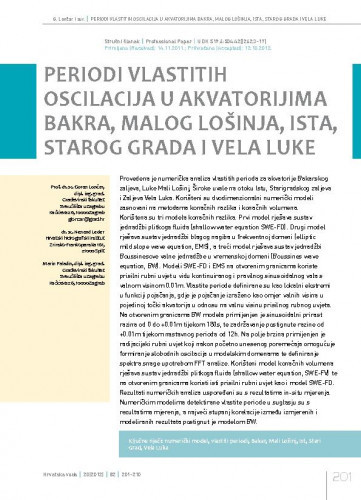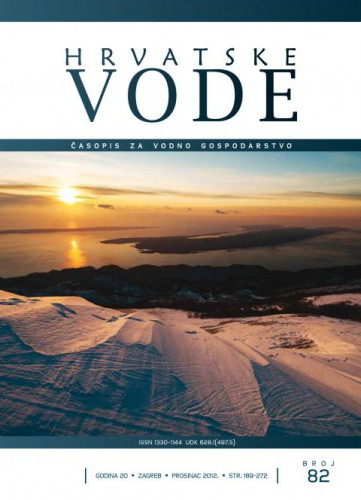Provedena je numerička analiza vlastitih perioda za akvatorije Bakarskog zaljeva, Luke Mali Lošinj, Široke uvale na otoku Istu, Starigradskog zaljeva i Zaljeva Vela Luka. Korišteni su dvodimenzionalni numerički modeli zasnovani na metodama konačnih razlika i konačnih volumena. Korištena su tri modela konačnih razlika. Prvi model rješava sustav jednadžbi plitkoga fluida (shallow water equation SWE-FD). Drugi model rješava sustav jednadžbi blagog nagiba u frekventnoj domeni (elliptic mild slope wave equation, EMS), a treći model rješava sustav jednadžbi Boussinesove valne jednadžbe u vremenskoj domeni (Boussines wave equation, BW). Modeli SWE-FD i EMS na otvorenim granicama koriste prisilni rubni uvjet u vidu kontinuiranog i pravilnog sinusoidalnog vala s valnom visinom 0.01m. Vlastite periode definirane su kao lokalni ekstremi u funkciji pojačanja, gdje je pojačanje izraženo kao omjer valnih visina u pojedinoj točki akvatorija u odnosu na valnu visinu prisilnog rubnog uvjeta. Na otvorenim granicama BW modela primijenjen je sinusoidalni prirast razina od 0 do +0.01m tijekom 180s, te zadržavanje postignute razine od +0.01m tijekom nastavnog perioda od 12h. Na polje brzina primijenjen je radijacijski rubni uvjet koji nakon početno unesenog poremećaja omogućuje formiranje slobodnih oscilacija u modelskim domenama te definiranje spektra snage upotrebom FFT analize. Korišteni model konačnih volumena rješava sustav jednadžbi plitkoga fluida (shallow water equation, SWE-FV) te na otvorenim granicama koristi isti prisilni rubni uvjet kao i model SWE-FD. Rezultati numeričkih analiza uspoređeni su s rezultatima in-situ mjerenja. Numeričkim modelima detektirane vlastite periode u suglasju su s rezultatima mjerenja, a najveći stupanj korelacije između izmjerenih i modeliranih rezultata postignut je modelom BW..; A numerical analysis of own periods for the local waters of Bakar, Mali Lošinj, Ist, Stari Grad and Vela Luka was carried out by the application of 2D numerical models based on finite difference and finite volue methods. Three finite difference models were used. The first model solves the system of shallow water equations (SWE-FD). The second model solves the system of elliptic mild slope wave equations (EMS), whereas the third model solves the system of Boussinesq wave equations in the temporal domain (BW). The SWE-FD and EMS models use the force boundary condition at open boundaries in the form of continuous, regular sinusoidal wave with wave height of 0.01m. Own periods are defined as local extrema in the intensification function where intensification is expressed as ratio of the wave heights in a specific point of the aquatorium in relation to wave height of the force boundary condition. At open boundary of the BW model, increase in the sinusoidal level from 0 to +0.01m was applied during the 180s, as well as retention of the achieved level of +0.01m during the subsequent 12-hour period. The radiation boundary condition was applied to the velocity field, which, after initial disturbance input, enables the formation of free oscillations in the model domains, and the definition of a force spectrum through application of the FFT analysis. The applied finite volume model solves the system of shallow water equation (SWE-FV) and uses the same force boundary condition as the model SWE-FD at open boundaries. The results of numerical analyses were comapred with the results of in-situ measurements. Numerical models detected own periods in correlation with the measurement results. The highest achieved correlation level was between the measured and modelled results of the BW model.
Sažetak
Dio sveska

